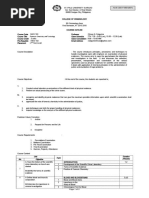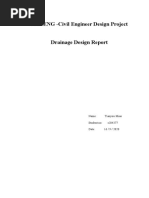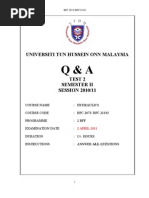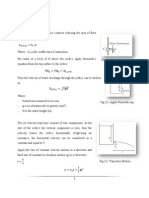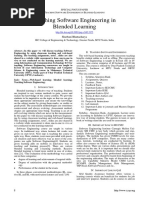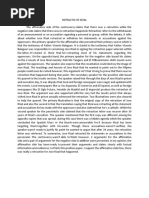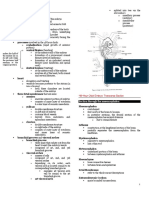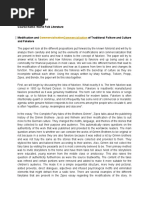Exp 1
Exp 1
Uploaded by
Jennifer BurnettCopyright:
Available Formats
Exp 1
Exp 1
Uploaded by
Jennifer BurnettOriginal Description:
Original Title
Copyright
Available Formats
Share this document
Did you find this document useful?
Is this content inappropriate?
Copyright:
Available Formats
Exp 1
Exp 1
Uploaded by
Jennifer BurnettCopyright:
Available Formats
Section:
45.5
40.94
42.35
cm
Bottom Level
19
33.78
18.95
cm
Sill height
15
Water Surface Level
cm
Width of the flume:
20
cm
Pitot tube
Index
27.5
13.4
14.1
cm
Static Head
28.65
25.19
25.76
cm
Dynamic Head
43.33
43.28
40.86
cm
Width of the Rehbock flume:
Rehbock gauge :
Index of the Rehbock gauge:
Discharge (Qm)
23.7
cm
23.15
cm
14.5
cm
0.0137
m3/sec
Notation
Reduced
Measuring
value
Units
Depth of flow in section 1
y1
0.265
Depth of flow in section 2
y2
0.0716
Depth of flow in section 3
y3
0.234
Discharge
0.0137
m3/s
Width of flume
Sill Height
b
a
0.2
0.15
m
m
Variable
Point gauge
Pitot tube
y2
y1
sill
Height of water
Index of Rehbock Gauge
Rehbock Weir
Q Calculated:
Q=
2 gb 2 ( y 1 y 2 a ) y
y 2 y
1
22
22
12
= y1 y2 b
y3
2 g ( y1 y2 a)
y 2 y 2
1
Q=
2 gb 2 ( y 1 y 2 a ) y
y 2 y
1
22
22
b1 =b2 = b=
y1=
y2=
a=
g=
12
= y1 y2 b
0.2
0.265
0.0716
0.15
9.81
2 g ( y1 y2 a)
y 2 y
1
22
m
m
m
m
m^2/S
So Qcalculated = 0.013724545
Q measured:
h=
0.0865
b = 0.23 m ( using b = 0.3 m for this calculation to meet the requirements of equation for Rehboc
b=
where:
0.3
Q measured =Q rehbock =C e
2
2 g bh 3
3
e2
Ce = 0.602 + 0.083 h/p = 0.6517
0.6515
he = h + k h
0.0877 he ^3/2=
kh = 1.2 m
0.0012 mm
p
g=
2g^0.5 =
so Q measured =
0.145 mm
9.81
4.429446918
0.01499003
Qcal-Qmeas
-0.00126548 m^3/S
0.02597164
h/p =
0.596552
Energy head calculations based on water depth and discharge measurement
v12/2g
Q=0.015 m3/s
v32/2g
v22/2g
y2=0.0899 m
y1=0.2698 m
y3=0.2443 m
sill
z1=0.00 m
a=0.1483 m
Z2=0.00 m
z3=0.00 m
a.Calculation of Energy Head from Measured Values of Water Depths and Discharge
bflume = 0.2 m
Location
Discharge
Area
Velocity (V)
H broad
Depth y
(m3/s)
(m2)
(m/sec)
Crest Weir
SECTION 1
SECTION 2
0.0137
0.0137
0.053
0.014
0.259
0.958
0
0
0
0.1500
0.265
0.0716
SECTION 3
0.0137
0.047
0.293
0.234
NOTE :
Velocity = Column 2 / column 3
Energy head = column 5 + column 6 + column 7 + column 8
b.Comparing with energy head following the measured dynamic head
Energy
Head
PITOT TUBE
SECTION
Static
Dynamic
Calculated
(m)
(m)
(m/sec)
SECTION 1
SECTION 2
0.1455
0.1109
0.2923
0.2918
0.26842
0.26842
SECTION 3
0.1166
0.2676
0.23838
CALCULATION OF WATER DEPTH, VELOCITY AND ENERGY HEAD
Calculation of water depth, velocity and energy head uses principles of conservation of mass (continuity)
Continuity equation: Q = A1 . V 1 = A2 . V2
Energy equation:
2
v1
v 22
z1 + y1 +
= z2 + y2 +
2g
2g
a.Calculation of y2, v2, E2 from measured y1 and Q
Continuity equation:
Q=b y 1 v 1 = b y 2 v 2 v1 =
Q
Q
and v 2 =
b y1
b y2
The Energy equation applied to section (1) and section (2) neglect the loss between section (2) and (1)
v22
v 21
z 2 +a + y 2 +
= z1 + y1 +
2g
2g
From Continuity equation and Energy equation:
2
2
y2 +
Q
Q
= y 1 + z1 a z2 +
2
2
2
2
2 g b y
2 g b y 1
2
To calculate y2 we use trial and error method
0.0768 0.11841779
trial y2
0.117492512
v2 =
Q
b y 2
v2 =
0.89352509
2
v
E2 = z 2 + a + y 2 + 2
2g
And then,
E2 =
0.2675
b.Calculation of y3, v3, E3 from measured y2 and Q
The height of y3 can be calculated these equations :
Continuity Equation :
Q=b y 2 v 2 = b y3 v 3 v 2 =
Energy Equation
Q
Q
and v 3 =
b y2
b y3
y 2 + a+
22
2g
v
= y3+
32
2g
+CarnotLoss
( v v )
CarnotLoss= 2 3
2g
depends on expansion condition, and it is a function of the shape and the angle of expansion. Here we a
v2 = velocity in the contraction, section 2
v3 = velocity in the expansion, section 3
v 2=
v
y 2 + a+
22
2g
v
= y 3+
y 3 = y 2 + a+
y3 =
Q
=
by 2
32
2g
v 2 v 2
2
2g
0.9759
+CarnotLoss
2
( v 2v 3 )
2g
By trial and error, we have y3 = 0.246 m
4
#DIV/0!
#DIV/0!
0.2268
ts of equation for Rehbock Equation, because b < 0.3 m)
s and Discharge
V2/2g
Energy
Head
0.00342
0.04682
0.26842
0.26842
0.00438
0.23838
ation of mass (continuity) and energy (Bernoulli) :
ween section (2) and (1)
le of expansion. Here we assume that = 1.
Section:
Water Surface Level
32.41
29.23
29.86
cm
Bottom Level
5.43
20.24
5.43
cm
Sill height
20.23
cm
Width of the flume:
20
cm
Pitot tube
Index
36.35
20.65
15.7
cm
Static Head
28.65
28.65
28.65
cm
Dynamic Head
43.8
41.64
41.24
cm
Width of the Rehbock flume:
Rehbock gauge :
Index of the Rehbock gauge:
Discharge (Qm)
23
cm
23.19
cm
14.5
cm
0.015
m3/sec
Notation
Reduced
Measuring
value
Units
Depth of flow in section 1
y1
0.2698
Depth of flow in section 2
y2
0.0899
Depth of flow in section 3
y3
0.2443
Discharge
0.015
m3/s
Width of flume
Sill Height
b
a
0.2
0.1483
m
m
Variable
Point gauge
Pitot tube
y2
y1
sill
Height of water
Index of Rehbock Gauge
Rehbock Weir
Q Calculated:
Q=
2 gb 2 ( y 1 y 2 a ) y
y 2 y
1
22
22
12
= y1 y2 b
y3
2 g ( y1 y2 a)
y 2 y
1
22
Q=
2 gb 2 ( y 1 y 2 a ) y
y 2 y
1
22
22
b1 =b2 = b=
y1=
y2=
a=
g=
12
= y1 y2 b
0.2
0.2698
0.0899
0.1483
9.81
2 g ( y1 y2 a)
y 2 y
1
22
m
m
m
m
m^2/S
So Qcalculated = 0.015015468
Q measured:
h = 0.2319 0.1450 =
0.0869
b = 0.23 m ( using b = 0.3 m for this calculation to meet the requirements of equation for Rehboc
b=
0.3
where:
Q measured =Q rehbock =C e
2
2 g bh 3
3
e2
Ce = 0.602 + 0.083 h/p = 0.6517
0.6517
he = h + k h
0.0881 he ^3/2=
kh = 1.2 m
0.0012 mm
0.145 mm
9.81
4.429446918
0.015098005
g=
2g^0.5 =
so Q measured =
Qcal-Qmeas
0.026149529
h/p =
0.59931
-8.254E-005 m^3/S
Energy head calculations based on water depth and discharge measurement
v12/2g
v32/2g
v22/2g
y2=0.0899 m
Q=0.015 m3/s
y1=0.2698 m
y3=0.2443 m
sill
z1=0.00 m
a=0.1483 m
Z2=0.00 m
z3=0.00 m
a.Calculation of Energy Head from Measured Values of Water Depths and Discharge
bflume = 0.2 m
Location
Discharge
Area
Velocity (V)
H broad
Depth y
(m3/s)
(m2)
(m/sec)
Crest Weir
SECTION 1
SECTION 2
0.0150
0.0150
0.054
0.018
0.278
0.835
0
0
0
0.1483
0.2698
0.0899
SECTION 3
0.0150
0.049
0.307
0.2443
NOTE :
Velocity = Column 2 / column 3
Energy head = column 5 + column 6 + column 7 + column 8
b.Comparing with energy head following the measured dynamic head
Energy Head
PITOT TUBE
SECTION
Static
Dynamic
Calculated
(m)
(m)
(m/sec)
SECTION 1
SECTION 2
0.1295
0.1295
0.2810
0.2594
0.2737
0.2737
SECTION 3
0.1295
0.2554
0.2491
CALCULATION OF WATER DEPTH, VELOCITY AND ENERGY HEAD
Calculation of water depth, velocity and energy head uses principles of conservation of mass (continuity)
Continuity equation: Q = A1 . V 1 = A2 . V2
Energy equation:
2
v1
v 22
z1 + y1 +
= z2 + y2 +
2g
2g
a.Calculation of y2, v2, E2 from measured y1 and Q
Continuity equation:
Q=b y 1 v 1 = b y 2 v 2 v1 =
Q
Q
and v 2 =
b y1
b y2
The Energy equation applied to section (1) and section (2) neglect the loss between section (2) and (1)
2
v
v
z 2 +a + y 2 + 2 = z 1 + y 1 + 1
2g
2g
From Continuity equation and Energy equation:
2
2
y2 +
Q
Q
= y 1 + z1 a z2 +
2
2
2
2
2 g b y
2 g b y 1
2
To calculate y2 we use trial and error method
trial y2 =
0.0768 0.12544671
0.125507553
Q
b y 2
v2 =
v2 = 0.977569536
2
v
E2 = z 2 + a + y 2 + 2
2g
And then,
E2 =
0.2738
a.Calculation of y3, v3, E3 from measured y2 and Q
The height of y3 can be calculated these equations :
Continuity Equation :
Q=b y 2 v 2 = b y3 v 3 v 2 =
Energy Equation
Q
Q
and v 3 =
b y2
b y3
v
y 2 + a+
22
2g
v
= y3+
32
2g
+CarnotLoss
( v 2v 3 )
CarnotLoss=
2g
depends on expansion condition, and it is a function of the shape and the angle of expansion. Here we a
v2 = velocity in the contraction, section 2
v3 = velocity in the expansion, section 3
v 2=
v
y 2 + a+
22
2g
= y 3+
y 3 = y 2 + a+
y3 =
Q
=
by 2
32
2g
v 2 v 2
2
2g
0.9829
+CarnotLoss
( v 2v 3 )2
2g
By trial and error, we have y3 = 0.274 m
v 3=
Q
b y 3
v
0.274344502
0.323588996
0.323589
v3 =
0.274
( v 2 v 3 )2
E3 = y 3 +
+
=
2g
2g
32
0.2251 0.050097 0.275197
0.3034
a.Comparing between Energy Head Sections 2 - 3 and energy head as determined in exercis
able 1.5. Resume of energy head for each method
PITOT TUBE EXERCISE 3 EXERCISE 4
Energy
(Based on
dynamic
head)
(Based on y
&Q
measured)
(Based on
Calculated)
E2
0.2594
0.2737
0.2738
E3
0.2554
0.2491
0.3034
From the table above, the values of energy head in each section are not the same for each
method. This might caused by the following reasons :
1. In Exercise 3, we measured the energy head in section 1, 2, and 3 directly
from the measured value of water depth and discharge, so there is no connection
with the value obtained from other sections. In Exercise 4, we calculate the
energy head using formula which requires condition in other section.
2. In Exercise 4, Carnot Loss between section 2 and 3 is not neglected.
3. Some systematic reading errors might happened during the experiment.
of equation for Rehbock Equation, because b < 0.3 m)
and Discharge
V2/2g
Energy
Head
0.00395
0.03555
0.27375
0.27375
0.00481
0.24911
on of mass (continuity) and energy (Bernoulli) :
en section (2) and (1)
of expansion. Here we assume that = 1.
determined in exercise 3
You might also like
- Forensic Chemistry and Toxicology: Acs-Cdd-F-003Document3 pagesForensic Chemistry and Toxicology: Acs-Cdd-F-003Chivas Gocela Dulguime83% (6)
- Design Summary TableDocument16 pagesDesign Summary Table周星星No ratings yet
- Assignment 2 Fluid Particles and ProcessesDocument29 pagesAssignment 2 Fluid Particles and ProcessesSenanLg100% (3)
- 2011 SolutionsDocument15 pages2011 SolutionsNSunNo ratings yet
- Design of Structural Elements Resit Marking GuideDocument3 pagesDesign of Structural Elements Resit Marking GuidetchiengangNo ratings yet
- Cive1400 200203Document7 pagesCive1400 200203naefmubarakNo ratings yet
- 345 S 02 P 4Document11 pages345 S 02 P 4khalidh2010No ratings yet
- Tos Lab ReportDocument15 pagesTos Lab ReportStephanieNo ratings yet
- Geankoplis 2.6-4 2.7-4Document7 pagesGeankoplis 2.6-4 2.7-4BenePicarNo ratings yet
- Q&atest 2 (2 April2011) 2073 HydraulicsDocument10 pagesQ&atest 2 (2 April2011) 2073 HydraulicsMuhamad Faiz ZulkiflyNo ratings yet
- Natural Convection and RadiationDocument7 pagesNatural Convection and Radiationhamzah aymanNo ratings yet
- E 5: W C A: XP Ater Hannel PplicationsDocument9 pagesE 5: W C A: XP Ater Hannel PplicationsMahmoudSehweilNo ratings yet
- Anley Assignment1Document19 pagesAnley Assignment1banitessew82100% (1)
- Canal Hydraulics - Numerical MethodDocument25 pagesCanal Hydraulics - Numerical MethodScribdTranslationsNo ratings yet
- pc1 ConcretoDocument21 pagespc1 Concretofio1704No ratings yet
- Experiment No. 9 Hydraulic Jump I. Objectives: To Observe The Hydraulic Jump in Open Channel Flow by The Use of Control Gates and WeirsDocument5 pagesExperiment No. 9 Hydraulic Jump I. Objectives: To Observe The Hydraulic Jump in Open Channel Flow by The Use of Control Gates and WeirsJohn Emerald GoloNo ratings yet
- Coriolli's Component of Acceleration ApparatusDocument7 pagesCoriolli's Component of Acceleration Apparatustinkusk24No ratings yet
- Bernoulli Equation': Darawan Obaid RamadanDocument7 pagesBernoulli Equation': Darawan Obaid Ramadanali najatNo ratings yet
- FLuid 535Document11 pagesFLuid 535عبدالله عبدالحكيم عامرNo ratings yet
- ShipTheory Project 2Document11 pagesShipTheory Project 2Barış YükselNo ratings yet
- CH 05Document14 pagesCH 05hirenpatel_universalNo ratings yet
- Assignment 0Document6 pagesAssignment 0Jeshua LloreraNo ratings yet
- Flow Over Weirs ReportDocument6 pagesFlow Over Weirs ReportميسرةNo ratings yet
- The Gauss-Seidel Method-Procedure & Example: δ =0 i = 2,3, ……………. G V =1, δ =0 i = G+1, G+2, ……… nDocument7 pagesThe Gauss-Seidel Method-Procedure & Example: δ =0 i = 2,3, ……………. G V =1, δ =0 i = G+1, G+2, ……… nSaikat MahmudNo ratings yet
- Elementary Mechanics and Thermodynamics SOLUTIONS MANUAL - J. Norbury PDFDocument112 pagesElementary Mechanics and Thermodynamics SOLUTIONS MANUAL - J. Norbury PDFsuryaaNo ratings yet
- University of Mauritius: Faculty of Engineering Mechanical & Production Engineering DepartmentDocument17 pagesUniversity of Mauritius: Faculty of Engineering Mechanical & Production Engineering Departmenthansley100% (1)
- Physics (1), English 1, IP 1Document15 pagesPhysics (1), English 1, IP 1fahadjubayer49No ratings yet
- De Cuong CNK Thuy Cong 1Document13 pagesDe Cuong CNK Thuy Cong 1Hạnh TồNo ratings yet
- ROUTE SURVEY-for StudentsDocument71 pagesROUTE SURVEY-for StudentsUsama IsmailNo ratings yet
- Thermofluids LabDocument14 pagesThermofluids Labحسين عمريNo ratings yet
- Exp 2 Cooling TowerDocument15 pagesExp 2 Cooling TowerFong Cai YingNo ratings yet
- Steel Structure AssignmentDocument11 pagesSteel Structure AssignmentGetaneh HailuNo ratings yet
- Streamflow MeasurementDocument65 pagesStreamflow MeasurementCt Kamariah Md SaatNo ratings yet
- Cve 654Document18 pagesCve 654Aremu OluwafunmilayoNo ratings yet
- Nsolution 2Document7 pagesNsolution 2Shankar DakshinamurthiNo ratings yet
- Wall Bounded Turbulent Part 2 (Solved Problems) PrintingDocument18 pagesWall Bounded Turbulent Part 2 (Solved Problems) PrintingJack HughesNo ratings yet
- 0 Intro To Pneumatics ModifiedDocument95 pages0 Intro To Pneumatics ModifiedRenoMa'rufYuniarNo ratings yet
- Final Exp 2Document3 pagesFinal Exp 2MuhammedNayeemNo ratings yet
- Table of ContentDocument10 pagesTable of ContentMuhammad UkashaNo ratings yet
- Tshoga Lo PDFDocument11 pagesTshoga Lo PDFlehlabileNo ratings yet
- WR3Document8 pagesWR3Chris AdaminovicNo ratings yet
- CL351: Chemical Engineering Lab-II Semester 1, 2014-2015 IIT GandhinagarDocument6 pagesCL351: Chemical Engineering Lab-II Semester 1, 2014-2015 IIT GandhinagarPradeep DiwakarNo ratings yet
- Correct Option Is (C) .: SolutionDocument271 pagesCorrect Option Is (C) .: Solutionyogeshkumar3089_8250No ratings yet
- HSC 1st Paper Expt 3 With ValueDocument6 pagesHSC 1st Paper Expt 3 With ValueKabir MdNo ratings yet
- Bernoulli and Torricelli Theorem Basics.Document49 pagesBernoulli and Torricelli Theorem Basics.shubhamcholeNo ratings yet
- HX 103Document13 pagesHX 103Weng Keat ChongNo ratings yet
- Akış Proje HeleshawDocument7 pagesAkış Proje HeleshawHakan SalmanNo ratings yet
- BESA Hydraulics Geotechnical Preboard Solutions 18 Feb. 2022Document35 pagesBESA Hydraulics Geotechnical Preboard Solutions 18 Feb. 2022Chaythina Corteza100% (1)
- Hydraulic Design of Canal RegulatorsDocument15 pagesHydraulic Design of Canal Regulatorsناهض عهد عبد المحسن ناهضNo ratings yet
- ENERGY LOSS FINAL REPORTIIDocument13 pagesENERGY LOSS FINAL REPORTIIyilomfanadmkNo ratings yet
- Final2 BDocument12 pagesFinal2 BBakkashreya SriNo ratings yet
- CounterDocument6 pagesCounterhamzah aymanNo ratings yet
- Counter FlowDocument6 pagesCounter Flowhamzah aymanNo ratings yet
- Chapter 22 Solutions: e W Q Q W Q WDocument32 pagesChapter 22 Solutions: e W Q Q W Q Wysrra94No ratings yet
- Analytical Modeling of Solute Transport in Groundwater: Using Models to Understand the Effect of Natural Processes on Contaminant Fate and TransportFrom EverandAnalytical Modeling of Solute Transport in Groundwater: Using Models to Understand the Effect of Natural Processes on Contaminant Fate and TransportNo ratings yet
- Hyrdoacoustic Ocean Exploration: Theories and Experimental ApplicationFrom EverandHyrdoacoustic Ocean Exploration: Theories and Experimental ApplicationNo ratings yet
- 3D Modeling of Nonlinear Wave Phenomena on Shallow Water SurfacesFrom Everand3D Modeling of Nonlinear Wave Phenomena on Shallow Water SurfacesNo ratings yet
- Modern Borehole Analytics: Annular Flow, Hole Cleaning, and Pressure ControlFrom EverandModern Borehole Analytics: Annular Flow, Hole Cleaning, and Pressure ControlNo ratings yet
- Enhanced Oil Recovery: Resonance Macro- and Micro-Mechanics of Petroleum ReservoirsFrom EverandEnhanced Oil Recovery: Resonance Macro- and Micro-Mechanics of Petroleum ReservoirsRating: 5 out of 5 stars5/5 (1)
- Student Solutions Manual to Accompany Economic Dynamics in Discrete Time, second editionFrom EverandStudent Solutions Manual to Accompany Economic Dynamics in Discrete Time, second editionRating: 4.5 out of 5 stars4.5/5 (2)
- Effects of Watering Regime (Wet and Dry) On Growth Responses of Ornamental Palm SpeciesDocument8 pagesEffects of Watering Regime (Wet and Dry) On Growth Responses of Ornamental Palm SpeciesJennifer BurnettNo ratings yet
- Table of Critical Values For T Two Tailed SignificanceDocument2 pagesTable of Critical Values For T Two Tailed SignificanceJennifer BurnettNo ratings yet
- UNESCO-IHE - Academic Calendar 2012/2014Document1 pageUNESCO-IHE - Academic Calendar 2012/2014Jennifer BurnettNo ratings yet
- Invitation Field Work Arnhem 2015Document1 pageInvitation Field Work Arnhem 2015Jennifer BurnettNo ratings yet
- Name: Julianto Silalahi Student Number: 31201 Program: He - LWDDocument1 pageName: Julianto Silalahi Student Number: 31201 Program: He - LWDJennifer BurnettNo ratings yet
- Watershed Delineation Map: LegendDocument1 pageWatershed Delineation Map: LegendJennifer BurnettNo ratings yet
- Research Article: Emergy Analysis of Biogas Systems Based On Different Raw MaterialsDocument9 pagesResearch Article: Emergy Analysis of Biogas Systems Based On Different Raw MaterialsJennifer BurnettNo ratings yet
- Traveling To EnglandDocument9 pagesTraveling To EnglandJennifer BurnettNo ratings yet
- Iso-Iec 17067Document43 pagesIso-Iec 17067Por Jut100% (1)
- Cla 3 PDFDocument3 pagesCla 3 PDFRenz Caballero EspinosaNo ratings yet
- Decodable A Box of HatsDocument2 pagesDecodable A Box of HatsmsmoralesonlineNo ratings yet
- Prosthodontics Inroductory Lecture (Lecture #0)Document5 pagesProsthodontics Inroductory Lecture (Lecture #0)JustDen09No ratings yet
- Kumar AllamDocument1 pageKumar AllamKumar AllamNo ratings yet
- CO2 - Position Paper 2 Retraction of RizalDocument1 pageCO2 - Position Paper 2 Retraction of RizalJustein KeneptNo ratings yet
- Finalized QuestionnaireDocument6 pagesFinalized Questionnaireramon discion100% (2)
- Character Analysis of Morning in Nagrebcan by Manuel E. ArguillaDocument4 pagesCharacter Analysis of Morning in Nagrebcan by Manuel E. ArguillaMGNo ratings yet
- Management of Angry PatientDocument50 pagesManagement of Angry PatientMassy HaddyNo ratings yet
- Appointment With LoveDocument2 pagesAppointment With LoveReynel John A. ColobongNo ratings yet
- 48 Hour Chick Reviewer PDFDocument5 pages48 Hour Chick Reviewer PDFSheanna May FuriaNo ratings yet
- Case Sheet - Abdominal Lump in Right Lumbar RegionDocument5 pagesCase Sheet - Abdominal Lump in Right Lumbar RegionpradeepNo ratings yet
- A Primer On Workplace CounsellingDocument19 pagesA Primer On Workplace CounsellingPiaa Raj100% (1)
- ShriGuru Paduka PanchakDocument3 pagesShriGuru Paduka PanchakDaneNo ratings yet
- Gingival RecessionDocument22 pagesGingival RecessionAsmita Wankhede MeshramNo ratings yet
- Siddhartha Synthesis #1 PaperDocument4 pagesSiddhartha Synthesis #1 PaperSiddharth JindalNo ratings yet
- Kinds of PunishmentDocument4 pagesKinds of PunishmentEsha JavedNo ratings yet
- Gmail - Intimation of Show Cause Notice For Suo Moto CancellationDocument1 pageGmail - Intimation of Show Cause Notice For Suo Moto Cancellationram kumarNo ratings yet
- ChemistryDocument12 pagesChemistrysree ramNo ratings yet
- Scales As A Challenge For Vulnerability Assessment: Natural Hazards December 2010Document20 pagesScales As A Challenge For Vulnerability Assessment: Natural Hazards December 2010odinNo ratings yet
- Condensed Matter Physics: Introduction ToDocument19 pagesCondensed Matter Physics: Introduction ToMarcos ZalazarNo ratings yet
- KQ2 - To What Extent Was The League of Nations A SuccessDocument4 pagesKQ2 - To What Extent Was The League of Nations A SuccessJJ SNo ratings yet
- Strut Design - EurocodeDocument4 pagesStrut Design - EurocodeMonal RajNo ratings yet
- CKV Cultural Report 3Document4 pagesCKV Cultural Report 3api-340919545No ratings yet
- The Body in Theory - Essays After Lacan and Foucault - Becky R - McLaughlin (Editor), Eric Daffron (Editor) - 2021 - McFarland - 9781476678559 - Anna's ArchiveDocument194 pagesThe Body in Theory - Essays After Lacan and Foucault - Becky R - McLaughlin (Editor), Eric Daffron (Editor) - 2021 - McFarland - 9781476678559 - Anna's Archiveralvara2No ratings yet
- Networking - Multiple Ping Script in Python - Stack OverflowDocument7 pagesNetworking - Multiple Ping Script in Python - Stack Overflowyoyo maNo ratings yet
- People With: A Danger To Society?: SchizophreniaDocument2 pagesPeople With: A Danger To Society?: SchizophrenialawoffistsNo ratings yet
- Engineering Physics LaboratoryDocument14 pagesEngineering Physics Laboratorys d p vaishnavNo ratings yet
- Egyptian Mythology A to Z 3rd Edition Pat Remler 2024 scribd downloadDocument67 pagesEgyptian Mythology A to Z 3rd Edition Pat Remler 2024 scribd downloadfourdure58No ratings yet
